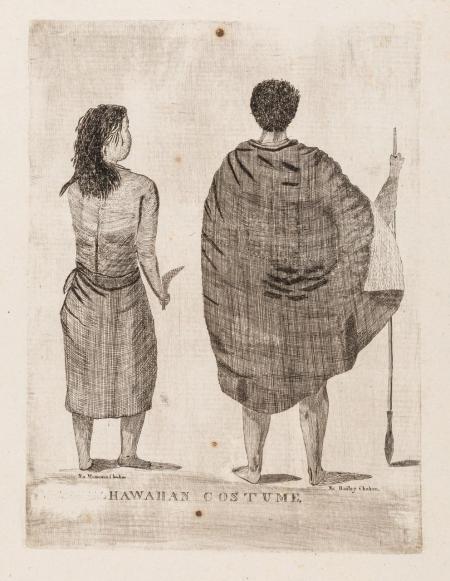
Hawaiian costume, engraved by William Mamona and drawn by Edward Bailey.
Catalog record
About this Resource | Early Printing in Hawaiian
People No Longer Known
Publication title pages rarely reveal the full story of the people and processes involved in producing the works. Throughout the history of printing, many of the people doing the physical labor to make printing and publishing possible are not acknowledged by name. For example, several Lahainaluna Seminary students were involved in collecting the histories and stories of Native Hawaiians for the Mo'olelo Hawaiʻi (History of Hawai’i). Yet, Davida Malo is the only contributor whose name is still known today.
Thanks to a grant from the Pine Tree Foundation, AAS staff have been able to identify and enhance information about many Hawaiian individuals involved in Hawaiian language printing and publishing. This allows us to acknowledge the crucial and often overlooked labor of individuals who are not in the historical record.
The General Catalog now identifies works known to have been produced by Native Hawaiians, whether named or unnamed. For additional information on finding works by Indigenous creators see Finding Materials for Indigenous Peoples Studies.
Native Hawaiian Artists and Engravers

Detail of Kalama's engraved signature on Mission houses, Honolulu, 1837. Catalog record Kalama, Simona P.
also known as: Simona Petero Kalama, S. P. (Simona Petero) Kalama Waiawaawa, or Simona P. Kalama WaiawaawaSimona Petero Kalama Waiawaawa was born in 1822 at Kalamawaiʻawaʻawa in Nāpoʻopoʻo in Hawaiʻi and grew up in Lahaina. While attending the Lahainaluna Seminary from around 1834 to 1839, he became a skilled cartographer and engraved many maps. In 1841, Kalama joined a United States Exploring Expedition, led by Captain Charles Wilkes, that collected specimens of molten lava at Kilauea Crater on the island of Hawaiʻi. When the ledge they were on began to sink, Kalama pulled a missionary named Judd to safety. (See Forbes, D.W. Engraved at Lahainaluna, 2021, p. 21.) Eventually, Kalama became a land surveyor and landowner and held government positions in Hawaiʻi in the House of Representatives, Privy Council, and circuit court of Honolulu. He died on December 9, 1875.
Kaleohano (1831-1896)
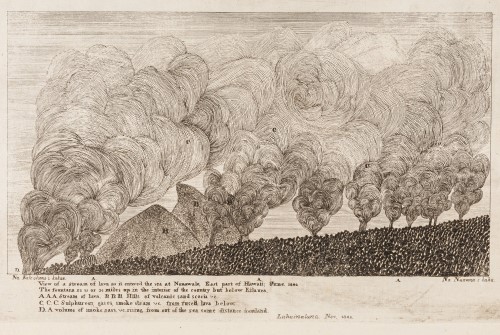
Kaleohano was named as the artist on View of a Stream of Lava as it Entered the Sea at Nanawale, 1840.
Catalog recordKaleohano was born in 1831 in Pulehu, Maui, to members of the aliʻi (Hawaiian nobility), who had converted to Christianity. Beginning in 1840, Kaleohano attended the Lahainaluna Seminary for four years and during that time was named as the artist on one engraving. After graduation, he married a woman named Kaahanui, and as of 1858, was working as a teacher in Wailuku, Maui.
In 1851, Kaleohano and Kaahanui became some of the earliest converts to Mormonism on the islands after meeting newly arrived Mormon missionary George Q. Cannon. (See below for more on The Church of Jesus Christ of Latter-day Saints (LDS).) Kaleohano became a prolific Mormon missionary in Hawaiʻi, completing seven missionary assignments throughout the islands between 1851 and 1854. He briefly distanced himself from the Mormon church in the 1860s during the controversial leadership of Walter Murray Gibson. After Gibson was excommunicated in 1864, Kaleohano resumed his involvement and was instrumental in establishing an LDS community in Lāʻie, where he moved with his family in 1865 to form an agricultural colony. While at Lā’ie, Kaleohano became the Hawaiian Monarchy’s primary contact for the Mormon church. He died in March 1896.
Kapeau, George Luther, -1860

Detail of Kapeau's engraved signature on Holden, 1838. Catalog record Born on Maui around 1811, George Luther Kapeau entered the Lahainaluna Seminary around 1833 and graduated in 1837. Later, he held several positions within Kamehameha III’s government, including as an advisor in the Privy Council from 1847 to 1854, a member of the House of Nobles from 1848 to 1855, a judge in the Maui circuit court, and deputy governor of the Island of Hawaiʻi. During this period, Kapeau corresponded with fellow Lahainaluna engraver Momona in their government capacities. He died in October 1860.
Kepohoni, L. (Lutera)
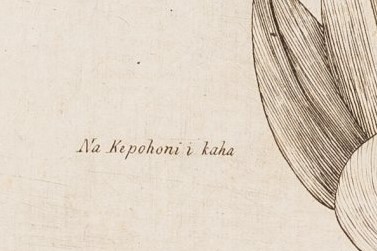
Detail of Kepohoni's engraved signature on The Night- Blooming Cerius, ca. 1840. Catalog record Lutera Kepohoni was one of the most prolific engravers who worked at Lahainaluna Seminary. Little is known about him, but he was likely an apprenticed local, presumably from Lahaina, where in 1847 he owned a house at Kuholilea. In a letter dated that year, he wrote to Lahainaluna, asking to "re-establish my job... Whereas it was I who did the tasks Andrews [missionary Lorrin Andrews and first principal at the seminary] held in his hands from the years 1836 to 1844." (Letter in Hawaiʻi State Archives cited in Forbes, D.W. Engraved at Lahainaluna, 2021, p. 23.)
Momona, William, -1857
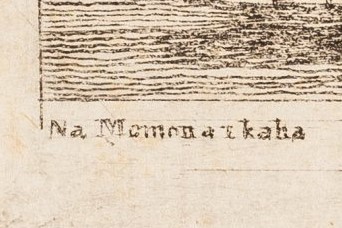
Detail of Momona's engraved signature onThe Diamond Hill as Seen From Honolulu, 1838 or 9. Catalog record William Momona, from Keauhou, Hawaiʻi, entered the Lahainaluna Seminary around 1833 and remained as a student for four years and possibly longer in another capacity. In 1836, he was dismissed from the seminary for adultery, reinstated after an apology, and dismissed again in 1840. Sometime in the 1840s, Momona became a judge in the third judicial district of the Hawaiʻi Supreme Court and in the 1840s and 1850s, exchanged several letters with fellow Lahainaluna engraver Kapeau in their official government capacities. Momona died in 1857.

Detail of Nuuanu's engraved signature on the map View of a Stream of Lava as it Entered the Sea at Nanawale, 1840. Catalog record Nuuanu (Engraver)
Originally from Waialua, Oahu, Nuuanu entered the Lahainaluna Seminary in 1836 and remained there as a student for five years. As of 1858, he lived in Honolulu and held a job in the government.

Detail of Pikao's engraved signature on the map Aina Moana, 1842. Catalog record Pikao, N.
Hailing from Honolulu, Pikao attended the Lahainaluna Seminary for at least four years, beginning in 1836. In 1839, he was suspended for "direct willful disobedience" and again later in the year was "excluded from school." (See Forbes, D.W. Engraved at Lahainaluna, 2021, p. 25.) Pikao died by 1858.
Native Hawaiian Newspaper Editors
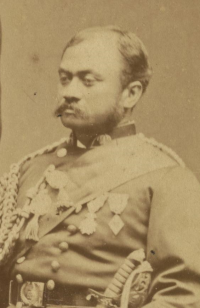
Kapena
Hawaiʻi State Archives,
PC 1,107-AKapena, J. M. (John Makini), 1843-1887
John Mākini Kapena, born in 1843 in Lahaina, Maui, was an established politician and diplomat in the Kingdom of Hawaiʻi. Kapena served as governor of Maui from 1874 to 1876, minister of finance from 1876 to 1878, and minister of foreign affairs from 1878 to 1880, among various other roles. In 1870, Kapena became the editor of Ke Au Okoa, until it merged with Ka Nupepa Kuokoa to become Ka Nupepa Kuokoa Me Ke Au Okoa I Huiia (not at AAS) in 1873.
Kawainui, Joseph U., 1841-1895
Born on Maui around 1841, Joseph U. Kawainui came to Honolulu as a child to attend the Royal School (originally called the Chief’s Children’s School as it was intended for children of the aliʻi). Around 1870, he was hired as a reporter by Henry Martyn Whitney, the publisher of Ka Nupepa Kuokoa. Eventually, Kawainui became an editor of Kuokoa. In 1878 he started his own publication, Ko Hawaii Pae Aina (not at AAS), which he published until 1892. He then took up his former position of editor of Kuokoa until his death in 1895.
Mahoe, Samuel Kauhanehonokawailani, 1845-1918?
S.K. Mahoe likely refers to Samuel Kauhanehonokawailani Mahoe, who was hired as an editor of Ka Nupepa Kuokoa in 1878. Mahoe was instrumental in printing Hawaiian language newspapers and preserving Hawaiian history. According to his obituary, Mahoe served “many terms” in the royal Hawaiian government until his death.
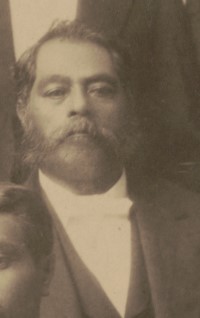
Kaunamano
Wikimedia CommonsKaunamano, J. K. (John K.), 1830-1902
Kaunamano established the newspaper Ka Hoku o ka Pakipika (not at AAS), described as the first Hawaiian language newspaper established by a Native Hawaiian. Kaunamano was also involved in government, as indicated by his signature on a government report in 1892.
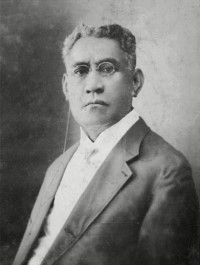
Poepoe
Wikimedia CommonsPoepoe, Joseph Mokuʻōhai, 1852-1913
Joseph Mokuohai Poepoe, born in 1852 in Honomakau, Hawaiʻi, came to Honolulu as a child to attend the Royal School (first known as the Chief’s Children’s School). He received his Hawaiian law license in 1884 and later became a teacher at the British Government School in Ainakea. He also ran several times for government office as part of the Democratic Party of Oahu nei. Poepoe earned recognition as an editor for many Hawaiian language newspapers on Oahu, including Ka Nupepa Kuokoa under Henry Martyn Whitney. He died in 1913.
Hawaiian Sovereigns
The Kingdom of Hawaiʻi flourished between 1795 (or 1810, if including all the islands) and 1893 under a series of sovereigns most of whom took the name Kamehameha. The first Kamehameha, who united the islands in 1810, was not involved in printing since he died in 1819, just a few months before the first U.S. and Native Hawaiian missionaries arrived with the printing press. The Hawaiian sovereigns that followed, however, actively embraced printing technology, primarily to promulgate laws and orders.
Hawaii. Sovereign (1825-1854 : Kamehameha III)
Kamehameha III reigned for almost 30 years, including under his mother’s regency during the early years. His most enduring legacy was establishing a constitutional monarchy in 1840 and adopting another constitution in 1852.
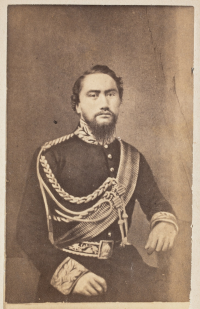
Kamehameha IV
Catalog recordHawaii. Sovereign (1854-1863 : Kamehameha IV)
Educated by US Protestant missionaries, Kamehameha IV succeeded his uncle when he was only twenty years old and reigned for less than ten years before his death. Politically, he opposed an annexation treaty with the United States, instead preferring a reciprocity treaty.
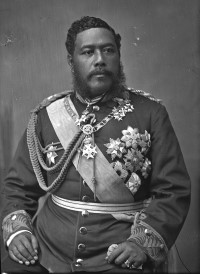
Kalakaua
Hawaiʻi State Archives,
PNLPC-5-07656Hawaii. Sovereign (1874-1891 : Kalakaua) or Kalakaua, David, King of Hawaii, 1836-1891
also known as: David Laʻamea Kamananakapu Mahinulani Naloiaehuokalani Lumialani KalākauaPublications by Kalākaua include speeches written in Hawaiian and English for the opening of the Legislative Assembly. He also published a book in English, The Legends and Myths of Hawaii (New York, 1888).
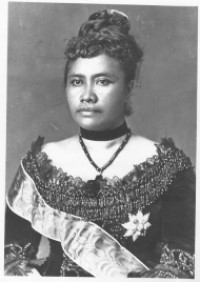
Liliuokalani
Hawaiʻi State Archives,
PP-98-10-005Liliuokalani, Queen of Hawaiʻi (1838-1917)
also known as: Lydia Liliʻu Loloku Walania Kamakaʻeha Pākī DominiThe last sovereign, Queen Liliʻuokalani, was also known by her married English name, Lydia Dominis. She took the name Liliʻuokalani when her brother Kalākaua designated her as heir apparent. She succeeded her brother in 1891, and two years later her government was overthrown. Liliʻuokalani wrote many songs in the Hawaiian language, which were preserved in printed form in the nineteenth century. Her English language book, Hawaii's Story by Hawaii's Queen, was published in Boston in 1898, the same year that the United States took over Hawaii.
Native Hawaiian Authors and Translators
Haleʻole, S. N.
S.N. Haleʻole (1819-1866) entered the school at Lahainaluna in 1834 and later became a teacher himself. Haleʻole wrote what is known as the first book-length literary text written by a native Hawaiian to appear in print. Ke Kaao o Laieikawai (1863), first published serially in the newspaper Ka Nupepa Kuokoa, told the traditional Hawaiian story of Laieikawai.
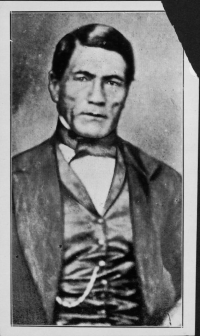
John Papa ʻIʻi
Hawaiʻi State Archives,
APP-73-4-009Ii, John Papa
also known as: John Kaneiakama Papa ʻIʻi; Ioane Kaneiakama Papa ʻIʻiBorn in 1800 on the island of Oʻahu, John Papa ʻIʻi began serving in the royal household of Kamehameha in 1810 at ten years of age. He went on to become an influential statesman. The compiled statutes of 1842 show that John ʻIʻi wrote some of those original Hawaiian laws. He also published biographical and historical accounts in the Hawaiian language newspaper Ka Nupepa Kuokoa from 1866 until his death in 1870.

S.M. Kamakau
Hawaiʻi State Archives,
AN-PNS-78-16899Kamakau, Samuel Manaiakalani, 1815-1876
Samuel Manaiakalani Kamakau remains one of the most important Hawaiian historians. He attended the Lahainaluna Seminary, where he later became a teacher's helper and began writing articles about Hawaiian culture and history. Kamakau helped found the first Hawaiian Historical Association in 1841, and in 1845, became the principal of a school in Kipahulu, Māui. From 1848 through his death in 1876, Kamakau held various government roles, including tenures in the House of Representatives and as a district judge. Kamakau wrote regular columns for Hawaiian newspapers throughout the 1860s on various subjects, including many on Hawaiian history.
Mahoe, J. H. (Joel H.), 1831?-1891
After converting to Christianity at a young age, Joel Hulu Mahoe became a Hawaiian pastor and missionary. A minister at the Hilo mission gave him the first name of Joel. Mahoe worked as a delegate of the Hawaiian Board to the Gilbert Islands. Proficient in the Gilbertese language, he assisted Gilbertese people who immigrated to the Hawaiian Islands and remained an advocate for the Gilbertese people until his death in 1891.
Malo, Davida, 1795-1853
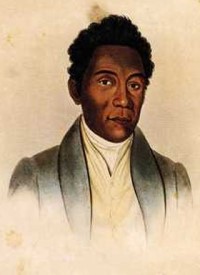
Malo fromThe Races of Man, 1848. Native Hawaiian speaker Davida Malo was integral to the translation of the Bible into Hawaiian. In addition, he wrote his own works in Hawaiian. Malo entered Lahainaluna Seminary when it was established in 1831 when he was 36. He attended the school for three years and later served as a school master. In 1827 Malo wrote one of the earliest books by a native Hawaiian, He Buke no ka Oihana Kula, an educational book that included a collection of Hawaiian genealogies. The original manuscript is at the Bishop Museum. It did not appear in print until the late twentieth century. Malo was one of the contributors to Ka Mooolelo Hawaii, printed in 1838, and he also wrote his own manuscript Mo'olelo Hawai'i, which was not printed until the early twentieth century. The compiled statutes of 1842 indicate Malo also wrote several of the original Hawaiian laws.
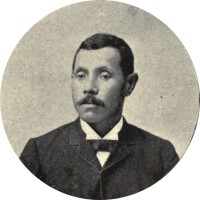
Nawahi, from History of later years of the Hawaiian Monarchy and the Revolution of 1893, 1896, after page 26. Catalog record Nawahi, Joseph Kahooluhi, 1842-1896
also known as: Joseph Kahoʻoluhi Nāwahī; Iosepa Kahoʻoluhi NāwahīokalaniʻōpuʻuJoseph Kahooluhi Nawahi was a Native Hawaiian legislator, lawyer, newspaper publisher, and painter. In 1857, after attending the Hilo Boarding School, Nawahi enrolled at the Lahainauna Seminary. After graduating from Lahainaluna, he continued his education at the Chief's School at Kahehuna.
A self-taught lawyer, Nawahi used his legal knowledge to pursue a career in politics. He was elected to the House of Representatives in 1872. Following the deaths of King Kamehameha V and Lunalilo in 1872 and 1874, respectively, Nawahi was one of six representatives to vote for Queen Emma of Hawaii, who was defeated by Kalakaua in the election.
Nawahi vehemently opposed the Reciprocity Treaty of 1875, calling it "he ku ʻikahi kaʻili aupuni" ("a nation-snatching treaty"). He believed the treaty would be the first step in the annexation of Hawaiʻi. Nawahi remained a strong defender of Hawaiian sovereignty and worked closely with Queen Lili'uokalani during the tumultuous latter half of the nineteenth century.
In 1894, Nawahi was arrested for treason because of his support for Hawaiian sovereignty. During his three months in prison, he contracted tuberculosis, which ultimately led to his death in 1896. Following his release from prison in early 1895, Nawahi and his wife Emma ʻAʻima Aʻii launched the weekly publication, Ke Aloha Aina (not at AAS), an anti-annexationist newspaper written in Hawaiian. The paper continued publishing until 1920.
Missionary Groups
American Board of Commissioners for Foreign Missions
One of the first Christian missionary groups founded in the United States, American Board of Commissioners for Foreign Missions (ABCFM) was formed in 1810, the same year Kamehameha united the Hawaiian Islands under his rule. Within a decade, ABCFM sent from their headquarters in Boston a group of Native Hawaiians and US missionaries to what they referred to as the "Sandwich Islands." Dozens of additional missionaries arrived on later boats until the ABCFM’s Sandwich Islands Mission was replaced by the Hawaiian Evangelical Association in 1854. Many children born to the US missionaries while on the islands thought of themselves as native-born Hawaiians, further complicating relationships between the groups.
Andrews, Lorrin, 1795-1868
Missionary Lorrin Andrews arrived on the Hawaiian islands in 1828. In 1831 he was chosen as the first principal of the Lahainaluna Seminary, where he served for ten years before abandoning the ABCFM. Andrews was an essential champion for setting up copperplate engraving in Lahainaluna Seminary and he also helped translate the New Testament of the Bible into Hawaiian.
Bailey, Edward, 1814-1903
Edward Bailey was born in Holden, Massachusetts, and attended Amherst College before sailing with his wife, Caroline, to Hawaiʻi in 1836. A teacher by training, Bailey worked at Lahainaluna Seminary and Wailuku Female Seminary until around 1850. Bailey painted over one hundred landscapes of Maui. While in Hawai’i, he also drew the main street of his hometown Holden, which Kapeau then engraved.
Taylor, Persis G. (Persis Goodale), 1821-1906
also known as: Miss Thurston or Persis Goodale Thurston TaylorPersis Goodale Thurston Taylor was an American artist born in 1821 to ABCFM missionaries living on Hawaiʻi. As a young adult, Thurston lived in Lahaina, Maui, where she worked for three years with students on the printing press at the Lahainaluna Seminary. Her paintings were engraved there.
Whitney, Henry M. (Henry Martyn), 1824-1904
Henry Martyn Whitney was born in 1824 to ABCFM missionaries on the island of Kauaʻi. Employed by the Kingdom of Hawaiʻi government printing office, Whitney worked as a journalist forThe Polynesian, and later in various other governmental roles. Whitney started the Pacific Commercial Advertiser in 1856; only a few early issues had Hawaiian language content. Partly in response to the publication of the Native Hawaiian-run Ka Hoki o ka Pakipika (not at AAS), Whitney established the Hawaiian language newspaper Ka Nupepa Kuokoa in 1861. Whitney strongly opposed the Hawaiian monarchy and advocated for the influence of US Protestants over the islands.
Armstrong, Richard, 1805-1860
also known as: LimaikaikaABCFM missionary Richard Armstrong arrived on the Hawaiian islands in 1832. Appointed as Minister of Public Instruction by King Kamehameha III, Armstrong was known for establishing the American-style public school system on Hawaiʻi. He edited several newspapers on the islands, including Ka Elele, Ka Elele Hawaii, and Ka Nonanona, a faith-based newspaper targeted at children. Armstrong sometimes published using the Hawaiian name Limaikaika, which translates to English as “strong hand or arm.”
Pula, J.
also known as: Josiah FullerJosiah Fuller (1814-1889) moved to Hawaiʻi from the U.S. likely as part of an ABCFM mission. In 1856, Fuller began publishing the Hawaiian-language newspaper Ka Hae Hawaii, which functioned as an official platform for the Hawai’i Department of Public Instruction. Fuller published under the Hawaiian name J. Pula.
Parker, H. H. (Henry Hodges), 1834-1927
The son of US Christian missionaries, Henry Hodges Parker was born on the Marquesas Islands. Two months after his birth in 1834, he moved to Hawaiʻi with his family after reassignment by the church because of civil unrest in the Marquesas. Parker was raised in Kaneohe, O’ahu, where he became fluent in Hawaiian and later a teacher at Lahainaluna High School on Maui. Parker served as the fourth Kahu (pastor) of the Kawaiaha’o Church in Honolulu. He held the position for 54 years and remains the longest-serving Kahu in history. From 1871 to 1874, Parker published Ka Lau Oliva, a Hawaiian-language newspaper serving the Kawaiaha’o Church community.
Catholic Missionaries
The ABCFM missionaries are heavily represented in the historical records, because they were the first to bring a printing press to the islands, However, they were not the only missionary group in Hawai’i. Catholic missionaries also attempted to win converts, and there was significant conflict between the two religious groups. The first Hawaiian language Catholic documents were printed in Paris, but the Palapala Katolika (Catholic Press) was not set up on the islands until they brought their own press in 1840.
The Church of Jesus Christ of Latter-day Saints
also known as: Latter-day Saints, LDS, Mormons
In December 1850, the Church of Jesus Christ of Latter-day Saints (LDS) sent ten missionaries to the Hawaiian Islands. The group included George Q. Cannon, who would go on to be a significant LDS leader and publisher. Half the initial group of missionaries returned to the U.S. in the first few months, but on August 6, 1851, Cannon organized the first branch of the Church in Hawaii in the village of Kealahou, Maui. Kaleohano, a Native Hawaiian teacher who in his school days had been the artist for one of the engravings done at Lahainaluna Seminary, served as clerk to that branch. By the end of 1853 there were nearly 3,000 Mormon converts in Hawai‘i.
Between 1852 and 1854, Cannon, worked with Native Hawaiian Jonatana, or Jonathan H. Nāpela, to translate the Book of Mormon into Hawaiian. Cannon published the Hawaiian translation, Ka Buke a Moramona (not at AAS), in San Francisco in 1855, and copies soon arrived in Hawai‘i. Today, Hawai‘i has one of the highest concentration of LDS church members in US states that do not border Utah.
Gibson, Walter Murray
also known as: KipikonaMormon missionary Walter Murray Gibson arrived in Hawai’i in 1861 and established himself on the island of Lānaʻi. By 1864, however, he was excommunicated from the church for preaching false doctrines and misappropriating funds. In the aftermath of the controversy, the Mormons left the island. In January 1865, Brigham Young purchased land in Lā‘ie, Oahu, for a new community of LDS members that Native Hawaiian Kaleohano was instrumental in founding. Gibson went on to seek political power in the Hawaiian government and through publishing newspapers. He was elected to the House of Representatives in 1878 as a candidate for the King’s Party, touting his alliance with King Kalakaua and proclaiming himself a voice of Hawaiians. He held many positions in the government, often at the same time, including Minster of Foreign Affairs, Attorney General, Minister of the Interior, and Secretary of War. Gibson started the newspaper, Nuhou, in 1873, printing in Hawaiian and English. Nuhou promoted Gibson and his political views, namely his staunch dedication to Hawaiian independence. In 1880, Gibson purchased the Pacific Commercial Advertiser.